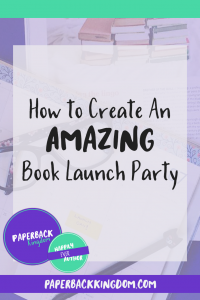Let me ask you something—have you ever sat down at your desk in the morning, cup of steamy coffee in one hand, and thought to yourself:
“Wow, I am absolutely psyched to market my book today!”
As someone who genuinely enjoys marketing, it would make my day to hear back “yes”. However, if you’ve clicked on this article, I’m willing to bet the answer is anything but that.
Luckily, marketing your book doesn’t have to be a frustrating, stressful and—to be frank—completely miserable process.
In fact, book marketing has become a whole lot easier and fun for authors who follow the four simple steps I’m about to share with you today.
These steps have helped authors to:
- Create clearer goals and achieve higher success rates with their marketing efforts.
- Engage with an audience that vibes well with them and is devoted to their books.
- Create a marketing strategy that is exciting, smooth and feels good to promote.
- Communicate better with their soulmate readers and feel less salesy, more authentic.
So, let’s take a look, shall we?
Step One: Find Your Purpose
This is the most important step of them all—if you don’t have a clear purpose for your marketing messages and efforts, it’s not going to feel easy or exciting for you at all.
To find your purpose, you need to ask yourself why you’re promoting your book—and more importantly, what you hope to get out of doing it.
You might desire to earn more sales, or gain more readership for your book. Maybe there’s a story behind your book you want to spread, or you want to build your mailing list before your next upcoming launch.
So instead of trying everything, try focusing on a select few marketing methods that will bring you that desired result:
- If you want sales, you need to directing people to where they can buy the book in an engaging way.
- If you want to increase readership, you can do this through community building and visibility strategies.
- If you want to get a story out, you should be focusing on networking with media and doing interviews.
- If you’re trying to build a mailing list, think about where your audience hangs out and how to direct them from that place to your list.
Step Two: Find The Right Audience
The next step will help you build off of the first one—you need to find your soulmate readers.
These are the people you want to be selling to, speaking to, and building a community with.
These are the people who will support your book, help you spread the word, and rave about it.
So once you know what outcome or goal you want to achieve, it’s time to get crystal clear on who you’ll be pitching to, selling to and speaking to in order to accomplish this goal:
- If you want sales, you need to know exactly who would be interested in buying your book. This needs to go deeper than your standard customer profile of “teenage bookworm”—you need to really get inside their head.
- If you want to increase readership, you need to know where this person hangs out and how to attract their attention—the better you understand who your soulmate reader is, the easier it will be to know what interests them.
- If you want to get a story out, you need to know the right people to work with to bring it into the public eye effectively—different media outlets have different audiences, after all.
- If you’re trying to build a mailing list, you need to have an opt-in that appeals to your soulmate reader—something they would love to obtain for free. (P.S: You can learn more about opt-ins in this post.)
Step Three: Find Your Flow
This is the step most authors yearn for—this is where we’re going to simplify marketing for good.
If you’ve ever felt like book marketing is a foreign language that you’re constantly trying to decipher—then this is the moment when you say “no more”.
Throw that shit out the window.
From today on, book marketing is going to be about what feels good and fun for you to do—because frankly, if it’s not easy or fun for you to implement, it won’t sell anyway.
It’s time to make a list of all the marketing methods you’re already aware of or using.
Once you’ve done this, I want you to cross out all the ones that feel too salesy, difficult or inauthentic.
(Quick note that some methods may seem difficult at first, but you might just have a lack of understanding about them—in which case, you may not want to disregard them just yet.)
In any case, our goal here is to shorten the list to methods that you actually enjoy creating and implementing—so that you can start doing these tasks on a consistent basis.
For example, you may have been told blogging is an essential tactic, but you may not have time to write blog posts or find it very difficult to write blogs that have actual value. However, you might really enjoy using Instagram for its visuals, and recording podcasts—in which case, you have found your flow strategy.
Don’t worry about what you’ve been told to do or what you’ve heard works better—just do what you love to do, and stay consistent with it.
That’s the key to gaining traction and marketing better.
A Note On Consistency…
Part of finding your flow is figuring out what works best for you in your personal schedule. So, if you can only churn out a blog post once a week, or update your Instagram once a day, that’s completely fine.
You should be showing up because you actually want to and you’re passionate to share the marketing content you have lined up—it’s way easier to post to Instagram daily or blog weekly when you’re sharing stuff you love talking about!
Step Four: Find Your Authenticity
This is the final step, where we take a look at the forced language in your captions, posts and emails. It’s likely happening because you’re not quite sure what to say, or how to say it—you just know you need to be posting something in an attempt to sell your book.
Don’t hate me, but solving this problem is really as simple as… you ready for it?
Being. Yourself.
Yep!
So how do we be ourselves online, in front of thousands of strangers?
It’s kind of like when you go to a party and you meet a bunch of new people, and you have this “nice first impression” persona plastered all over yourself. It’s not until maybe the third time you guys interact that you share a personal story or reveal how crazy you are after a glass of wine.
It can be hard to open up online because, first of all, you’re not sure how people are going to react, but second of all, you can’t really gauge the audience’s reaction in real time because it’s all online!
But here’s the good news—if you are crystal clear on who your ideal readers are, you don’t need to worry about any of this because regardless of who you truly are behind that flawless persona, they are totally going to vibe with you!
Like attracts like—you being you will attract people who want to engage and connect with YOU for being YOU.
Pretty cool, right?
So let’s break down that barrier and figure out how to bridge the gap so that you can start showing up as yourself!
Here’s a couple of questions to mull over which will help:
- Why do I write, and what do I want my readers to feel when reading my work?
- Who am I in real life—what are five personality traits I have?
- What do I feel comfortable sharing online?
- How do I talk to my friends and family?
^That last one is especially important.
So, to help you get a better grasp on this, I’m going to share my answers for who I am:
- I write because I enjoy writing stories that arouse emotions in my readers and have exciting twists—and I want them to feel entertained, connected to the characters, and shocked often.
- I am funny (or I like to think I am), a little sarcastic, kind but stubborn, and dramatic—which often shows in many of my social media captions.
- I am actually comfortable sharing a lot online—I will share my workflow, parts of my personal life, my backstory, my jokes (as bad as they are sometimes) and my achievements.
- I talk to my friends and family in a very casual manner—I will tell them what’s on my mind, my thoughts and opinions, my ideas, exciting announcements, and I don’t hide how I feel. Over the years, I have become more comfortable speaking like I do to my friends and family to my online audience.
Now it’s your turn! 😉
Once you have your questions answered, it’s time to put this all together:
- Set a goal for what you want to achieve through your marketing.
- Get crystal clear on who your soulmate reader / target audience is.
- Outline a marketing strategy made up of marketing methods that feel fun and good to you.
- Be yourself—use phrases you’d use in real life, share stories, reveal your quirks, and pretend like you’re just talking to your best friend, not the entire internet.
Bye bye, miserable book marketing days—see you never!

Written by Pagan Malcolm
Pagan is a copywriter and business coach helping writers understand the business side of publishing so that they can become serious authors.
| Facebook Group | Instagram | Podcast | Website | Blog |
